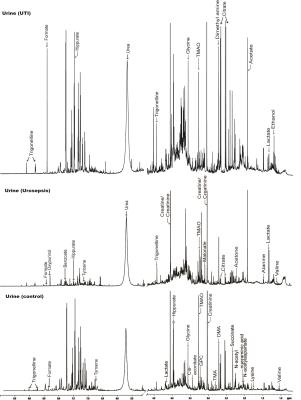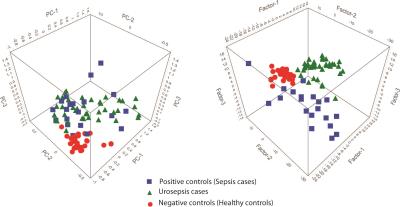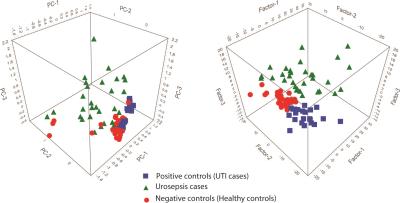5604
Comprehensive Metabolic Profiling of Urosepsis with positive and negative controls1Centre of Biomedical Research, Lucknow, India, 2Department of Microbiology, Dr. Ram Manohar Lohia Institute of Medical Sciences, Lucknow, India, 3Department of Urology, Dr. Ram Manohar Lohia Institute of Medical Sciences, Lucknow, India
Synopsis
This study presents the metabolic perturbation in serum and urine samples while comparing Urosepsis with negative and positive controls. It explores the metabolic differentiation of serum samples with sepsis and urine samples with urinary tract infection (UTI) (considered as positive controls), and healthy controls (considered as negative controls) respectively. The serum and urine metabolic profile mainly depicted changes occurring due to severity and spread of infection. The statistical Partial Least Square Discriminant Analysis (PLS-DA) model was robust enough to differentiate the three groups distinctively in both serum and urine samples.
Introduction
Urosepsis is one of the most dreaded diseases, defined as sepsis caused by urinary tract infection1. Urosepsis may be associated with multi-organ dysfunction syndrome (MODS), hypo-perfusion or hypo-tension and is thus considered a medical emergency. It has been established as the common cause of death world-wide2. Proton NMR based metabolic profiling of serum and urine samples of Urosepsis cases performed earlier by our group3 revealed that 1H NMR metabolic profiling can be utilized as a rapid and efficient differential diagnostic tool for Urosepsis. The variation in lactate and glucose levels was found to be similar to that of septicemia. It was therefore thought worthwhile to compare the changes occurring in the metabolic profile of small molecular weight metabolites in serum samples of sepsis and urine samples of UTI cases (constituted as positive controls for this study) for classifying Urosepsis more specifically.Purpose
Since urosepsis is defined as complicated UTI leading to sepsis, the differentiation of metabolic profile of urine with UTI cases and serum with sepsis cases (considered as positive controls) was investigated by exploring the potential advantages of metabolomics using 1H NMR spectroscopy (Figure 1 & 2).Material and Methods
A total of eighty three subjects were enrolled for the study, out of which thirty one were categorised as cases of urosepsis, twenty two samples were sepsis cases (for comparing serum) and UTI cases (for comparing urine) considered as positive controls while remaining thirty comprised the negative control group with samples collected from healthy individuals having neither any clinical abnormalities (such as diabetes, any infection, etc) nor any disease case history in the past. Serum and urine were collected as per the standard protocols4. One dimensional CPMG pulse sequence was used for recording spectra of serum samples and 1D NOESY with water presaturation experiment for urine samples respectively. The recorded spectral data was then binned into rectangular buckets of 0.01 ppm size, and subjected to unsupervised multivariate Principal Component Analysis (PCA) followed by supervised PLS-DA using “The Unscrambler X” software package (Version 10.0.1, CAMO, ASA, Norway).Results
A clear differentiation of urosepsis cases with negative (healthy) controls was observed through PCA of serum samples whereas the metabolic profile was found to be somewhat similar with those of positive controls (sepsis cases) (Figure 3). However, supervised PLS-DA considering the Y-variables showed a clear differentiation between diseased cases and controls (both positive as well as negative controls) using full cross validation method. Metabolic profiling of serum showed mainly an elevation of lactate levels and depletion of glucose in both positive controls and urosepsis cases while comparing with negative controls, along with elevation of lysine, acetone, DMA, choline and depletion of alanine in majority of sepsis cases. The urine metabolic profiling separated all the uroseptic cases distinctly from both the positive and negative controls through both PCA and PLS-DA models (Figure 4). The metabolic profiling of urine revealed an up-regulation of 1, 3- propane diol, acetate, citrate DMA, TMA, choline containing compounds, urea, tyrosine, histidine and hippurate only in UTI cases and lactate and alanine in both urosepsis and UTI cases. The down-regulation of β-hydroxy butyrate in UTI cases and citrate, DMA, TMAO, creatinine, urea and hippurate specifically in urosepsis cases was also observed.Discussion
The 1H NMR metabolic profile of serum of the cases was found to be severely altered in earlier studies3, with elevated levels of lactate and decreased levels of glucose while comparing with negative controls. On the other hand, comparison with positive controls (sepsis cases) mainly indicated the severity of infection during different stages of sepsis despite of hyperlactatemia and hypoglycemia which is a general observation in both urosepsis and sepsis cases. The urine metabolic profile was found to be different with those of earlier reported UTI cases. This may be attributed to the complications arising due to spread of the infection (UTI) into the urinary bladder causing cystitis, followed by pyelonephritis, and ultimately leading to urosepsis.Conclusion
On the basis of metabolic profiling and statistical models generated (using full cross validation method) for all the three groups together, it was found that there was a clear separation of positive, negative controls and urosepsis cases in both serum and urine samples. Further studies on larger cohorts would be needed in order to determine the significance of these findings in a larger patient population.Acknowledgements
The authors are thankful to Dr. Ram Manohar Lohia Institute of Medical Sciences for Intramural funding and Centre of Biomedical Research, Lucknow where the present study was conducted. We are grateful to Dr. S. K. Mandal (Consultant and Bio-statistician) at our Centre for cross-checking the statistical results.References
1. Mikkelsen ME, Miltiades AN, Gaieski DF, et al. Serum lactate is associated with mortality in severe sepsis independent of organ failure and shock. Crit Care Med. 2009; 37:1670-1677.
2. Dellinger RP, Levy MM, Carlet JM, et al. Surviving Sepsis Campaign: International guidelines for management of severe sepsis and septic shock: 2008. Crit Care Med 2008; 36:296-327.
3. Singh S, Chatterji T, Sen M, et al. Serum procalcitonin levels in combination with 1HNMR spectroscopy: A rapid indicator for differentiation of urosepsis. Clin. Chim. Acta 2016; 453: 205-214.
4. Beckonert O, Keun HC, Ebbels TM, et al. Metabolic profiling, metabolomic and metabonomic procedures for NMR spectroscopy of urine, plasma, serum and tissue extracts. . Nature Protocols 2007; 2:2692-2703.
Figures



